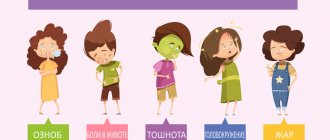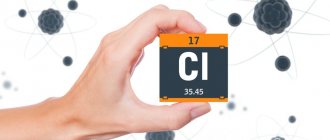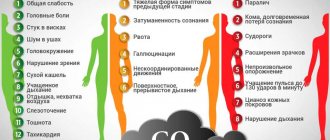Intoxication of the body is a general concept that characterizes poisoning with psychoactive and other substances. It implies a whole range of symptoms that develop against the background of poisoning. Intoxication can be determined both by external manifestations and symptoms, and by laboratory tests in some cases.
According to the WHO, “the term is most often used in relation to alcohol consumption - its equivalent in everyday speech is “intoxication”” (https://www.who.int/substance_abuse/terminology/acute_intox/ru/). However, it is important to understand that such a diagnosis can only be the main one in cases where poisoning is not associated with other disorders caused by the use of alcohol or psychoactive substances. In other words, the symptoms of one-time alcohol poisoning or accidental ingestion of toxic substances can be called intoxication. With constant intentional use, we will be talking about a dependence syndrome or a psychotic disorder.
There are many toxic components and types of intoxication that are not associated with drinking alcoholic beverages. Therefore, a classification was developed that determines the route of entry of harmful substances into the body and the mechanisms of development of poisoning.
Types of poisoning
Depending on the routes through which the poison enters the human body, scientists distinguish:
Inhalation poisoning
With this method of poisoning, toxic substances enter the bronchi and lungs with inhaled air.
Inhalation drugs include:
- poisoning by vapors of acids and alkalis;
- carbon monoxide poisoning;
- ammonia poisoning;
- household gas poisoning;
- chlorine poisoning;
- mercury vapor poisoning.
Similar poisonings are possible at chemical industry enterprises, metallurgy and other industries. Providing first aid in case of gas poisoning or toxic fumes at work, when there are many victims, is carried out in special protective equipment.
In everyday life, people more often suffer from carbon monoxide or natural gas leaks. First aid for carbon monoxide poisoning is to take the victim to fresh air!
Contact poisoning
In this case, toxins enter the body through the skin or mucous membranes.
Contact poisonings include:
- pesticide poisoning;
- fluoride salt poisoning;
- benzene poisoning;
- petroleum product poisoning;
- formaldehyde poisoning.
First aid for poisoning is as follows: the victim should be immediately removed from the area affected by the toxic substance, remove his clothes, remove the poison from the skin with a cloth or cotton wool, and wash the toxic substance from the skin with running water and soap.
Poisoning due to an insect, animal or snake bite
The poison enters through a skin defect (bite, wound). The first thing to do in case of poisoning at home is to place an ice pack on the bite site; if a limb has been damaged by the bite, then a venous tourniquet is applied above the bite site to reduce the spread of poison through the bloodstream.
Oral poisoning (by mouth)
Such poisonings include:
- food poisoning;
- alcohol poisoning;
- drug poisoning;
- mushroom poisoning;
- chemical poisoning.
First aid for poisoning should be started at the first signs of intoxication.
Gastric lavage and siphon enema are performed. If the patient is unconscious, in case of poisoning with caustic substances, lavage is carried out through a gastric tube.
The most common cases are household poisoning, food poisoning, alcohol poisoning and mushroom poisoning. The nervous, respiratory and digestive systems of the body are most affected by the effects of the toxic substance. Providing first aid for poisoning is aimed at stopping the effects of poison on the body.
The main condition for first aid in case of poisoning is emergency hospitalization in intensive care or toxicology departments, where antidote therapy and artificial detoxification are possible.
Classification of intoxications
There are two broad groups of intoxications. Exogenous involves the entry of toxins into the body from the outside. The treatment of such conditions is carried out by toxicologists, and less often by infectious disease specialists in cases where the disease is caused by pathogens that produce exotoxins (for example, tetanus). Symptoms of intoxication in this case are specific. Therapy involves the mandatory use of toxoids or antidotes. Exogenous intoxication, caused by external factors, develops when natural or synthetic toxins enter the body. Exogenous intoxication includes the following types:
- food poisoning;
- alcohol poisoning;
- drug intoxication;
- poisoning with nitrites, heavy metals, etc.
With endogenous intoxication, toxins are produced directly in the patient’s body. In this case, the syndromes vary in severity. Intoxication occurs as a result of the accumulation of toxic substances in the body. There are several types of such substances:
- products of normal metabolism that accumulate in excessively high concentrations: ketone bodies, lactic acid, urea, etc.;
- products of metabolic disorders: alcohols, carboxylic acids, aldehydes, etc.;
- substances formed as a result of cellular decay from pathological foci (tumor necrosis factor) or from the gastrointestinal tract (lipase, cationic proteins, etc.);
- biologically active substances: serotonin, interferons, etc.
The causes of intoxication by one’s own products and substances include violations of the body’s adaptation mechanisms: weakening of defenses, gas exchange, etc. In this case, the balance of tissue reactions is lost. This disrupts metabolic processes and homeostasis (constancy of the internal environment). In this case, the substances become endotoxins, although they are not such under normal human health conditions.
Intoxications are classified according to the severity of symptoms, as well as how long ago the syndrome developed. The following types are distinguished:
- Acute
. This is a condition that occurs as a result of a single, short-term exposure to toxins. Symptoms of acute intoxication are pronounced and increase quickly. Exogenous (external) intoxication includes: food poisoning, consumption of large amounts of alcohol, medications, ingestion of plant poisons, etc. It is important to get medical help as quickly as possible. Delayed treatment can have fatal consequences.
- Chronic
. This condition is caused by prolonged exposure to toxins in the body, usually in small doses and intermittently. Such intoxication may be the result of the intake of toxic substances from the external environment. For example, when smoking, working with pesticides, and also while taking medications. Toxins are often produced in the body due to illness or metabolic disorders. Poisoning can occur with hidden symptoms or manifest itself in a pronounced form.
Intoxication syndrome is classified according to severity into mild, moderate, severe and fatal.
First aid for food poisoning
In case of food poisoning, the “culprits” are most often foods contaminated with pathogenic microbes or containing microbial toxins. The source of infection can also be water contaminated with bacteria.
Symptoms of poisoning develop quite quickly - from half an hour to several hours after eating.
What to do in case of poisoning?
It is necessary to clear the stomach of the toxic substance as soon as possible. This can be done before the ambulance arrives, by washing the stomach with 1-2 liters of boiled water or a weak solution of potassium permanganate, and giving an anti-poisoning gel - Enterosgel.
In case of diarrhea, it is necessary to replenish fluid loss by giving the patient unsweetened tea and salted water.
First aid if a child is poisoned by poor quality food can be provided by parents.
What can be done:
- Rinse the stomach;
- Provide plenty of fluids;
- Give Enterosgel sorbent (safe and recommended from the first days of life);
- Call a doctor.
First aid for poisoning in adults also involves taking Enterosgel sorbent, which effectively absorbs toxins in the intestines. In the absence of diarrhea, the doctor prescribes an enema or the patient is given a saline laxative to remove the toxic substance from the intestines, and detoxification therapy is prescribed.
The main causes of food poisoning:
• toxic infections – staphylococcal toxicosis and botulism, mycotoxicosis, mixed toxic infections, etc.; • toxic organic and inorganic substances; • violation of food production technology and improper storage, non-compliance with temperature conditions; • contamination, contamination of food with bacteria; • products that have become toxic under the influence of various factors and pesticides, nitrates, herbicides, fungicides accumulated in the peel and core of vegetables, berries and fruits; • unwashed vegetables and fruits, poor food hygiene.
An excellent environment for the growth of bacteria are multi-component salads, brawn and aspic, meat dishes, desserts with a cream base, canned mushrooms and dried fish. If you have even the slightest doubt about the suitability of foods intended for human consumption, it is better to refuse them.
Alcohol poisoning
The first first aid for alcohol poisoning is gastric lavage. Thanks to this simple procedure, you can remove drunk alcohol and reduce its absorption in the stomach, thereby reducing alcohol intoxication. After cleansing the stomach of the remnants of “strong” drinks, you need to give the victim Enterosgel sorbent and place him under a blanket.
If a person is unconscious, it is necessary to urgently call an ambulance and lay him on his side - this will reduce the likelihood of vomit getting into the upper respiratory tract.
First aid for alcohol poisoning in a hospital setting involves detoxification therapy, restoring the functioning of vital organs and systems. In a good way, everyone should know what the symptoms of alcohol poisoning look like and what to do if they are detected.
Prohibitions to remember
All of the above methods of providing first aid to people with alcohol intoxication should be used while the doctor is on the way. Imagining oneself as a luminary of science and trying to cure a person with severe poisoning is very risky. There is no need to give the patient medication. The only exceptions are sorbents that speed up the elimination of alcohol. But before using them, you should carefully read the information in the instructions.
Many drugs cannot be combined with ethyl alcohol. But only doctors know about this. It turns out that, wanting to alleviate the suffering of an alcohol addict, relatives can harm him. Illiterate drug correction can even lead to failure of vital organs. This is deadly.
It is forbidden to give a person a hangover
the day after the feast. Drinking alcohol does make you feel better for a while, but it increases the level of intoxication. This means that the toxic load on the body becomes more pronounced. Then it will take a very long time to recover.
Doctors prohibit dousing a person who has taken a large amount of alcohol with ice water or steaming them in a sauna or bathhouse. All these are extreme methods of traditional treatment. Often, it is after their implementation that cardiac failure begins. It is better to call a narcologist and wait for his arrival.
Attention! Attempts to lavage the stomach of a person who is in a semi-conscious or unconscious state lead to suffocation with vomit and instant death. You cannot induce vomiting if the patient loses consciousness.
First aid for mushroom poisoning
Inexperienced mushroom pickers often become victims of toadstool poisoning. Mushroom poison causes damage to the central nervous system, liver and kidneys. Therefore, first aid for poisoning with poisonous mushrooms should be provided by doctors!
How can you help a person before the doctor arrives?
After you have called an ambulance, first aid for mushroom poisoning at home consists of gastric lavage. It should be rinsed until the rinsing waters become clear. After this, you can give the victim Enterosgel sorbent.
First aid for carbon monoxide poisoning
Gas poisoning (CO) is a severe intoxication of the body, which can lead to severe damage to internal organs. According to statistics, carbon monoxide poisoning occupies a leading position among the causes of death from acute poisoning, so it should be taken extremely seriously.
Symptoms of carbon monoxide poisoning:
- Headache;
- Drowsiness;
- Chest pain;
- Redness of the skin;
- Hallucinations;
- Dry cough;
Severe gas poisoning is accompanied by loss of consciousness.
It is important to recognize these symptoms in time and start treatment at home in a timely manner!
Providing first aid for carbon monoxide poisoning
First of all, you need to take the victim out of the contaminated room into fresh air and free him from restrictive clothing. To reduce intoxication, give him Enterosgel sorbent and urgently call an ambulance.
First aid for carbon monoxide poisoning is the antidote - acizole. It is recommended to administer the drug as early as possible in case of poisoning of any severity.
A few words about poisons
According to scientists, any substance that enters the body can cause poisoning - after all, much depends not only on the concentration of the poison, but also on its quantity. Substances that are common and necessary for normal functioning of the body can become toxic in excessive quantities.
Under certain circumstances, even ordinary water can become dangerous: if you drink about 7 liters per day, you can get acute poisoning and even die from intoxication. Symptoms of water poisoning are associated with disruption of water and electrolyte metabolism in the body: swelling, cramps, vomiting, interruptions in heart function, diarrhea.
Toxic substances can enter the human body in all possible ways: through the mouth, skin, respiratory organs, by injection into the rectum, vein or ear canal. The severity of poisoning, symptoms and treatment, emergency measures to remove poison from the body depend on the type and amount of the toxic substance, and, of course, on the routes of its penetration.
The first symptoms of poisoning may appear immediately after the poison enters the body or within several hours or even days. First of all, the brain, liver, kidneys, and intestines are affected by toxic substances. These organs “give signals” - symptoms of poisoning that cannot be ignored!
Chlorine poisoning
The cause of poisoning with chlorine and its compounds can be violations of safety regulations in chemical laboratories or industrial accidents when containers with chlorine are damaged.
What symptoms of poisoning with chlorine-containing substances may bother the victim? First of all, this is swelling of the eyelids, oral mucosa, respiratory tract, shortness of breath, pain in the eyes, suffocation.
Timely first aid for chlorine poisoning can prevent a terrible complication - pulmonary edema!
What needs to be done? Remove the victim from the room saturated with chlorine vapors, remove clothing soaked in poison, wash exposed and damaged skin with soap and water, wash eyes and rinse mouth. After this, you should give the poisoned person the Enterosgel sorbent and call an ambulance.
First aid for drug poisoning
Drug poisoning can be accidental or intentional. Poisoning in young children occurs due to the fault of adults - tablets are sometimes in a place accessible to children. In case of poisoning at home, it is advisable to find out before the doctor arrives the medicine that the victim took and induce vomiting, then rinse the stomach with warm water and give Enterosgel sorbent.
Providing first aid will help avoid disorders of the cardiac, respiratory and nervous systems.
In a hospital setting, treatment with antidotes, control of intoxication and other resuscitation techniques are carried out to restore the function of internal organs.
First aid for poisoning with acids and alkalis
It is important to remember that in case of poisoning with alkalis and acids that enter through the mouth, it is under no circumstances recommended to rinse the stomach ! The mucous membrane of the digestive tract is covered in numerous chemical burns, and washing can cause gastrointestinal bleeding or perforation of the organ wall.
Toxicologists know which specific antidote to use for poisoning with alkalis and acids, as well as how to provide first aid for poisoning with chemicals, so if a toxic substance gets inside, immediately call an ambulance!
First aid for poisoning by acid vapors and other volatile substances
Inhalation poisoning, which occurs as a result of inhaling vapors of toxic substances, is considered one of the most severe types of intoxication. From the lungs, the poison quickly penetrates the blood and spreads throughout the body. Therefore, it is important to provide first aid in case of poisoning with gas and toxic vapors of chemicals. The victim must immediately be taken out into fresh air, loosen tight clothing, rinse his mouth with water or a soda solution and call an ambulance.
If a person is unconscious, it is necessary to provide the victim with a flow of fresh air, lay him down with his head elevated and wait for the doctor to arrive.
Signs indicating severe intoxication
Symptoms of alcohol poisoning and vomiting appear a few hours after drinking or the next day. Narcologists often observe a reflex eruption of stomach contents with inclusions of blood. Bloody impurities indicate severe irritation of the gastrointestinal mucous membranes with alcohol or internal bleeding. Both reasons are very dangerous.
Ailments that occur the morning after drinking demonstrate an increase in the concentration of toxic acetaldehyde in the blood. The level of this component increases gradually. The more a person drinks, the worse his health will be.
There is no need to think that poisoning after drinking alcohol is safe. This is wrong. Of course, if a person does not have alcohol addiction and chronic diseases, he will most likely be able to recover on his own. However, no one can give such a guarantee. Refusal to receive medical advice is always bringing oneself closer to serious violations.
It is especially important to consult with a narcologist if, after drinking, you experience:
- nausea, vomiting;
- unproductive vomiting, due to which a large amount of saliva is released, it is not possible to drink even ordinary water;
- severe headaches;
- constant thirst;
- feeling of “goosebumps” running over the skin, numbness of the limbs;
- difficulties with orientation in space;
- a sharp increase or, conversely, decrease in blood pressure;
- gradual decline of basic neurological reflexes.
If vomiting that develops due to alcohol poisoning is very severe, a life-threatening disruption of the heart rhythm may occur. The person also runs the risk of falling into a coma and dying.
First aid for ammonia poisoning
Inhalation poisoning can occur during an industrial accident. In such an emergency, first aid for ammonia poisoning includes the following measures:
- Immediately remove victims from the contaminated area;
- Provide access to clean air;
- Allow the victim to rinse the mouth, throat, and nose with water;
- Rinse the skin on which the toxic substance has come into contact with running water;
- Rinse the stomach;
- Call an ambulance and the rescue service.











